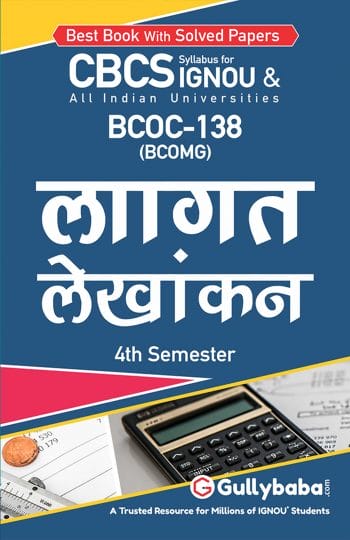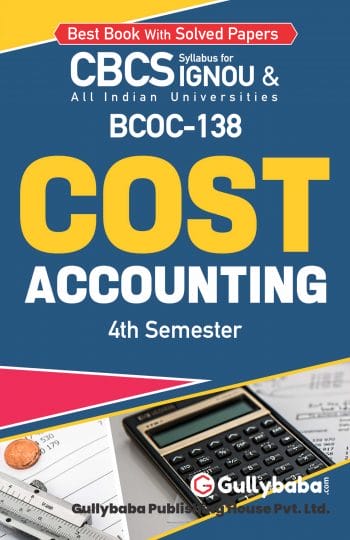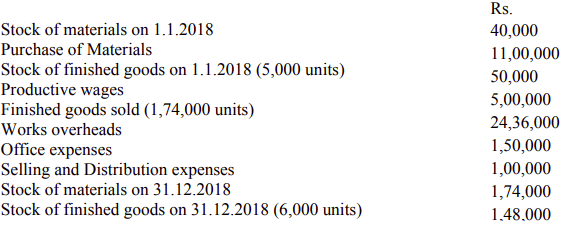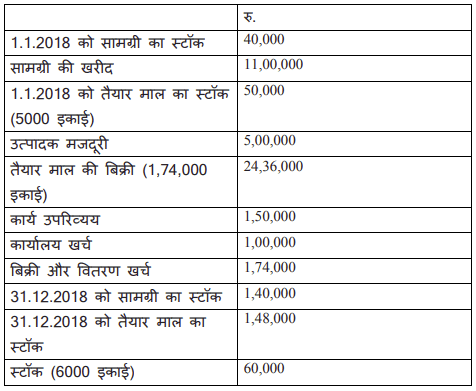Bought By: 10305
Rating: 4.8


BCOC–138 includes vital concepts of cost accounting. Topics covered in BCOC–138 include nature and scope of cost accounting, inventory control, labour accounting, overheads, job, unit, contract and process costing, need for costing, definitions of cost and cost accounting, the difference between cost accounting and financial accounting, advantages of cost accounting, installation of a costing system, meaning and classification of costs, cost unit and centre, components of the total cost, cost sheet, costing methods, types of costs, and the role of a cost accountant.
Get Good Marks in your BCOMG Finance and Accounting Programme in the Term-End Exams even if you are busy in your job or profession.
We've sold over 45,247,151 Help Books and Delivered 55,723,286 Assignments Since 2002.
As our customers will tell you...yes, it really result-oriented.
 Q.3 What is Labour Turnover? State the major causes of labour turnover.
Q.4 Define Overheads. What are the various methods of classifying overheads. Discuss functional classification.
Q.5 Calculate the machine hour rate to recover the overhead expenses given below :
Q.3 What is Labour Turnover? State the major causes of labour turnover.
Q.4 Define Overheads. What are the various methods of classifying overheads. Discuss functional classification.
Q.5 Calculate the machine hour rate to recover the overhead expenses given below :

 Section – B
Q.6 Explain the different methods of absorption of administrative overheads. Which method would you prefer and why?
Q.7 Define unit costing. Mention the industries to which this method of costing is applicable.
Q.8 Explain the use of a production order and give its specimen.
Q.9 How does contract costing differ from job costing?
Q.10 State the main characteristics of process costing and outline the costing procedure thereof.
Section – C
Q.11 Distinguish between the following:
a) Cost Accounting and Financial Accounting
b) Direct Expenses and Indirect Expenses
c) Centralised Purchasing and Decentralised Purchasing
d) Minimum Stock Level and Maximum Stock Level
Q.12 Write short notes on the following:
a) Cost Sheet
b) Time Keeping
c) Job Costing
d) Service Costing
Section – B
Q.6 Explain the different methods of absorption of administrative overheads. Which method would you prefer and why?
Q.7 Define unit costing. Mention the industries to which this method of costing is applicable.
Q.8 Explain the use of a production order and give its specimen.
Q.9 How does contract costing differ from job costing?
Q.10 State the main characteristics of process costing and outline the costing procedure thereof.
Section – C
Q.11 Distinguish between the following:
a) Cost Accounting and Financial Accounting
b) Direct Expenses and Indirect Expenses
c) Centralised Purchasing and Decentralised Purchasing
d) Minimum Stock Level and Maximum Stock Level
Q.12 Write short notes on the following:
a) Cost Sheet
b) Time Keeping
c) Job Costing
d) Service Costing Q.3 Explain centralized and decentralized purchasing systems along with their merits and demerits.
Q.4 Discuss different items that are taken into account while ascertaining the cost of materials. Support your answer with an illustration.
Q.5 The standard time allowed to complete a job is 100 hours and the hourly rate of wage payment is Rs. 5. The actual time taken by the worker to complete the job is 80 hours.
Calculate the total wages of the worker on the basis of :
i) Time Rate
ii) Piece Rate
iii) Halsey Plan
iv) Rowan Plan
Also compare the effective earnings per hour under the above methods.
Section – B
Q.6 What is meant by time keeping? Describe its forms and purpose.
Q.7 Discuss the characteristics, merits and demerits of time wage system and piece wage system.
Q.8 What is meant by apportionment of costs? Discuss the principles of apportionment.
Q.9 Define job costing. Explain its features and applicability.
Q.10 Giving an appropriate example, explain the calculation of equivalent production of work-in-progress.
Section – C
Q.11 Distinguish between the following:
a) Fixed overheads and variable overheads
b) Job costing and process costing
c) Joint-products and by-products
d) Integral accounting and non integral accounting
Q.12 Write short notes on the following:
a) Inventory control
b) Idle time
c) Incentive plans
d) Computation of transport service costing
Q.3 Explain centralized and decentralized purchasing systems along with their merits and demerits.
Q.4 Discuss different items that are taken into account while ascertaining the cost of materials. Support your answer with an illustration.
Q.5 The standard time allowed to complete a job is 100 hours and the hourly rate of wage payment is Rs. 5. The actual time taken by the worker to complete the job is 80 hours.
Calculate the total wages of the worker on the basis of :
i) Time Rate
ii) Piece Rate
iii) Halsey Plan
iv) Rowan Plan
Also compare the effective earnings per hour under the above methods.
Section – B
Q.6 What is meant by time keeping? Describe its forms and purpose.
Q.7 Discuss the characteristics, merits and demerits of time wage system and piece wage system.
Q.8 What is meant by apportionment of costs? Discuss the principles of apportionment.
Q.9 Define job costing. Explain its features and applicability.
Q.10 Giving an appropriate example, explain the calculation of equivalent production of work-in-progress.
Section – C
Q.11 Distinguish between the following:
a) Fixed overheads and variable overheads
b) Job costing and process costing
c) Joint-products and by-products
d) Integral accounting and non integral accounting
Q.12 Write short notes on the following:
a) Inventory control
b) Idle time
c) Incentive plans
d) Computation of transport service costing 3. श्रमिक आवर्त (Labour Turnover) क्या है ? बताएं कि श्रमिक आवर्त के प्रमुख कारण क्या हैं ?
4. उपरिव्यय की परिभाषा दीजिये । उपरिव्ययों के वर्गीकरण करने की विभिन्न विधियाँ क्या हैं ? कार्य अनुसार वर्गीकरण का विवेचन कीजिये ।
5. नीचे दिए गये उपरिव्यय खर्ची को वसूलने के लिये मशीन घंटा दर की गणना कीजिये ।
3. श्रमिक आवर्त (Labour Turnover) क्या है ? बताएं कि श्रमिक आवर्त के प्रमुख कारण क्या हैं ?
4. उपरिव्यय की परिभाषा दीजिये । उपरिव्ययों के वर्गीकरण करने की विभिन्न विधियाँ क्या हैं ? कार्य अनुसार वर्गीकरण का विवेचन कीजिये ।
5. नीचे दिए गये उपरिव्यय खर्ची को वसूलने के लिये मशीन घंटा दर की गणना कीजिये ।

 खंड - ख
6. प्रशासनिक उपरिव्ययों के अवशोषण की विभिन्न पद्धतियां समझाइये | आप कौन सी पद्धति पसंद करेंगे ? कारण दीजिये ।
7. इकाई लागत निर्माण विधि की परिभाषा दीजिये । वे उद्योग बताइये जिनमें लागत लेखों की इस विधि का प्रयोग किया जाता है ।
8. उत्पादन आदेश के उपयोग का वर्णन कीजिए और उसका नमूना दीजिए ।
9. ठेका लागत निर्धारण विधि उपकार्य लागत निर्धारण विधि से किस प्रकार भिन्न है ?
10. प्रक्रिया लागत निर्धारण विधि की मुख्य विशेषताएं बताइये और इसकी कार्य विधि बताइये।
खंड - ग
11. निम्नलिखित में अंतर स्पष्ट कीजिये:
क) लागत लेखांकन और वित्तीय लेखांकन
ख) प्रत्यक्ष व्यय और अप्रत्यक्ष व्यय
ग) केंद्रीकृत क्रय और विकेंद्रीकृत
घ) न्यूनतम स्टॉक सीमा और अधिकतम स्टॉक सीमा
12. निम्नलिखित पर संक्षिप्त में टिप्पणियाँ लिखिए:
क) लागत विवरण
ख) समय लेखन
ग) जॉब लागत निर्धारण
घ) सेवा लागत निर्धारण
खंड - ख
6. प्रशासनिक उपरिव्ययों के अवशोषण की विभिन्न पद्धतियां समझाइये | आप कौन सी पद्धति पसंद करेंगे ? कारण दीजिये ।
7. इकाई लागत निर्माण विधि की परिभाषा दीजिये । वे उद्योग बताइये जिनमें लागत लेखों की इस विधि का प्रयोग किया जाता है ।
8. उत्पादन आदेश के उपयोग का वर्णन कीजिए और उसका नमूना दीजिए ।
9. ठेका लागत निर्धारण विधि उपकार्य लागत निर्धारण विधि से किस प्रकार भिन्न है ?
10. प्रक्रिया लागत निर्धारण विधि की मुख्य विशेषताएं बताइये और इसकी कार्य विधि बताइये।
खंड - ग
11. निम्नलिखित में अंतर स्पष्ट कीजिये:
क) लागत लेखांकन और वित्तीय लेखांकन
ख) प्रत्यक्ष व्यय और अप्रत्यक्ष व्यय
ग) केंद्रीकृत क्रय और विकेंद्रीकृत
घ) न्यूनतम स्टॉक सीमा और अधिकतम स्टॉक सीमा
12. निम्नलिखित पर संक्षिप्त में टिप्पणियाँ लिखिए:
क) लागत विवरण
ख) समय लेखन
ग) जॉब लागत निर्धारण
घ) सेवा लागत निर्धारण 3. केंद्रीकृत और विकेन्द्रीकृत क्रय विधियों को उनके लाभ और हानियों सहित स्पष्ट कीजिए।
4. सामग्री की लागत का निर्धारण करते समय सम्मिलित की जाने वाली विभिन्न मदों की विवेचना कीजिए। अपने उत्तर को उपयुक्त उदाहरण की सहायता से स्पष्ट कीजिए ।
5. किसी कार्य को पूरा करने का निर्धारित मानक समय 100 घंटे है और प्रति घंटा मजदूरी दर 5 रुपए है। श्रमिक ने इस कार्य को 60 घंटे में पूरा किया। निम्नलिखित के आधार पर श्रमिक की कुल मजदूरी का परिकलन कीजिए|
(i) समयानुसार
(ii) कार्यानुसार
(iii) हैलसे योजना
(iv) रोवन योजना और इन विधियों के अंतर्गत श्रमिक के प्रति घंटा पारिश्रमिक की तुलना कीजिए ।
खण्ड ख
6. समय लेखन का क्या अर्थ है? इसके विभिन्न रूपों और उद्देश्यों को वर्णन कीजिए ?
7. समयानुसार मजदूरी पद्दति की विशेषताओं, लाभ और हानिओं का विवेचन कीजिए ।
8. लागत के अनुभाजन का क्या अर्थ है? अनुभाजन के सिद्धांतों का वर्णन कीजिए ।
9. जॉब लागत निर्धारण विधि को परिभाषित कीजिए । इसकी विशेषताओं और प्रयोग को स्पष्ट कीजिए ।
10. उपयुक्त उदाहरण की सहायता से चालू कार्य के समतुल्य उत्पादन की गणना विधि स्पष्ट कीजिए।
11. निम्नलिखित में अंतर स्पष्ट कीजिए :
क) स्थायी उपरिव्यय और परिवर्तनीय उपरिव्यय
ख) जॉब लागत निर्धारण और प्रक्रिया लागत निर्धारण ग) संयुक्त उत्पाद और उपोत्पाद
घ) समाकलित लेखांकन और असमाकलित लेखांकन
12. निम्नलिखित पर टिप्पणी लिखिए:
क) स्टॉक नियंत्रण
(ख) निष्कार्य समय
ग) प्रेरणात्मक योजनाएं
घ) परिवहन सेवा लागत की गणना
3. केंद्रीकृत और विकेन्द्रीकृत क्रय विधियों को उनके लाभ और हानियों सहित स्पष्ट कीजिए।
4. सामग्री की लागत का निर्धारण करते समय सम्मिलित की जाने वाली विभिन्न मदों की विवेचना कीजिए। अपने उत्तर को उपयुक्त उदाहरण की सहायता से स्पष्ट कीजिए ।
5. किसी कार्य को पूरा करने का निर्धारित मानक समय 100 घंटे है और प्रति घंटा मजदूरी दर 5 रुपए है। श्रमिक ने इस कार्य को 60 घंटे में पूरा किया। निम्नलिखित के आधार पर श्रमिक की कुल मजदूरी का परिकलन कीजिए|
(i) समयानुसार
(ii) कार्यानुसार
(iii) हैलसे योजना
(iv) रोवन योजना और इन विधियों के अंतर्गत श्रमिक के प्रति घंटा पारिश्रमिक की तुलना कीजिए ।
खण्ड ख
6. समय लेखन का क्या अर्थ है? इसके विभिन्न रूपों और उद्देश्यों को वर्णन कीजिए ?
7. समयानुसार मजदूरी पद्दति की विशेषताओं, लाभ और हानिओं का विवेचन कीजिए ।
8. लागत के अनुभाजन का क्या अर्थ है? अनुभाजन के सिद्धांतों का वर्णन कीजिए ।
9. जॉब लागत निर्धारण विधि को परिभाषित कीजिए । इसकी विशेषताओं और प्रयोग को स्पष्ट कीजिए ।
10. उपयुक्त उदाहरण की सहायता से चालू कार्य के समतुल्य उत्पादन की गणना विधि स्पष्ट कीजिए।
11. निम्नलिखित में अंतर स्पष्ट कीजिए :
क) स्थायी उपरिव्यय और परिवर्तनीय उपरिव्यय
ख) जॉब लागत निर्धारण और प्रक्रिया लागत निर्धारण ग) संयुक्त उत्पाद और उपोत्पाद
घ) समाकलित लेखांकन और असमाकलित लेखांकन
12. निम्नलिखित पर टिप्पणी लिखिए:
क) स्टॉक नियंत्रण
(ख) निष्कार्य समय
ग) प्रेरणात्मक योजनाएं
घ) परिवहन सेवा लागत की गणनाTo attend IGNOU BCOC-138 Term-End Examination, you must first submit your Assignments to the university and it is possible from the BCOC-138 study material. You can solve all necessary Assignments using Help Books. This will help in gaining good marks.
All best wishes with our efforts that you do not meet any obstacle before attending examinations next year. You can pass the BCOMG Finance and Accounting Programme Annual Exams with a good grade using Books/Materials from any one place at home or anywhere else!
ALL THE BEST!!!
Team GullyBaba